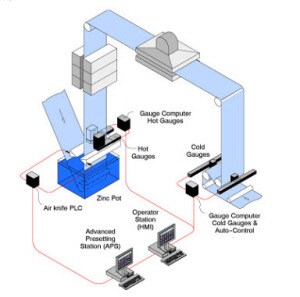Zinc (Zn) is a natural component of the earth and is present in rock, soil, air, and water. It’s a vital element for the human body, but it’s also one of the most widely-used industrial metals. In the manufacturing world, zinc is used to coat steel, which is used in construction and in numerous consumer products including cars and home appliances. (View this infographic to learn more interesting facts about zinc.)
Zinc coating is the most effective and widely used material to prevent corrosion, maintain the strength, and increase the longevity and performance of the steel. Zinc coating is applied to steel by hot dip galvanizing (HDG), a process by which the steel is passed through a bath of molten liquid zinc or zinc alloy resulting in a protective layer. This galvanized steel is produced at a worldwide rate of nearly 100 million tons each year, and demand for high-quality products is strong. HDG is one of the best ways to produce superior, homogenously coated products in a cost-effective manner.
The final quality of galvanized steel strip depends on various aspects such as material surface, zinc adhesion, and uniform coating weight. Proper substrate cleaning and strip temperature control govern the first two parameters, but the third, coating weight, is often measured too late in the process to correct. In fact, many producers verify hot dip zinc coating weight after the coil exits the mill. At this point, if the results are unacceptable the entire coil must be downgraded or scrapped — causing delays, wasted raw materials, and expense.
For HDG lines, automatic coating weight control is essential for uniform production with minimized zinc consumption. The solution to getting the exact weight measurement of zinc coating on steel strip is to measure it during the production process rather than after. X-ray fluorescence (XRF) is an excellent technology to achieve the precision required for such measurements without costly and lengthy delays in production. Online metal coating weight gauges based on XRF technology have proven successful for non-contact coating weight measurement configurable for nearly every type of metal coated product, especially for total zinc coating weight measurements on the difficult-to-measure galvanneal coated sheet.
The measuring units of these gauges use x-ray or gamma ray generators as the source of radiation for coating weight measurement. These sources provide fast response times with all the specific advantages of x-ray generation. The photons from the x-ray source cause XRF radiation to be generated in the coated strip. The XRF radiation is detected by application specific detectors mounted within the measuring unit. With the use of specially designed filters, selective coating weight measurement of various metal layers on the strip is possible.
A critical factor to successful measurement using an XRF-based online coating weight gauge is to create custom calibration standards based on the user’s individual coating processes. Each line should provide all samples required for calibration of their coating weight gauge and for verification of its performance.
Another important factor in obtaining accurate measurement is the placement of the sensors on the coating gauge. A recent white paper, The Benefits of “Hot” Coating Weight Measurements to Coating Control, examines the improvement gained by placing the sensors on the “hot” end of the hot dip galvanizing line, rather than the typical “cold” end. A measuring system placed at the cold end of the hot dip galvanizing line is about 120 meters behind the air knife. In a hot coating weight gauge, the measuring system is only two meters behind the air knife, with a dead time of only about one second. The auto control performance increases significantly in a hot system because the sensors can react to process parameter changes in near-real time, eliminating costly mistakes before they happen and saving on raw materials (zinc). If the measuring equipment consists of both a cold gauge and a hot gauge, the autocontrol can run in cascaded mode. In this case, the cold gauge provides the reference input value for the coating weight set points of the hot gauge. Incorporating coating thickness data from hot and cold sensors, this architecture evaluates long-term modifications in production, and automatically adapts the behavior of the controller to new production conditions.
Read this paper to learn about the ideal architecture for a coating weight measurement and control system which continuously improves its internal control algorithms by comparing the predicted coating weight with measured values.
Additional Resources:
- Download our free eBook: A Practical Guide to Improving Steel Manufacturing Processes and Production Methods
- Visit our center for Improving Steel Manufacturing Processes and Production








[…] Quality of Galvanized Steel Might Depend on Zinc Coating Weight Zinc coating is the most effective and widely used material to prevent corrosion, maintain the strength, and increase the longevity and performance of the steel. Zinc coating is applied to steel by hot dip galvanizing. Read the article and access the white paper to learn about the ideal architecture for a coating weight measurement and control system which continuously improves its internal control algorithms by comparing the predicted coating weight with measured values. […]